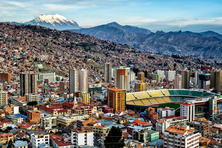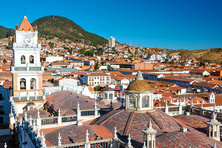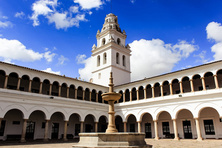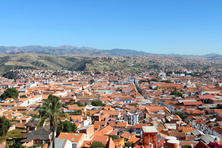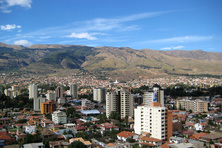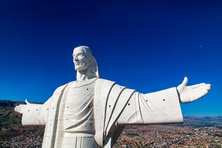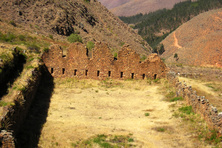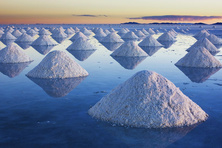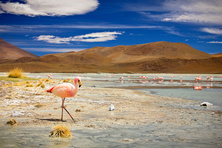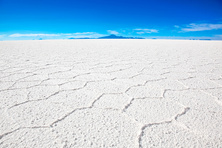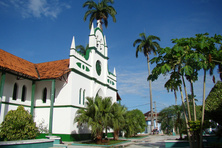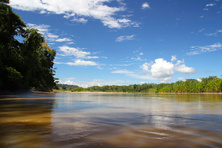Bolivia
- Capital:Sucre
- Currency: Boliviano
- Time: UTC-4
- Languages: Spanish, Quechua, Aymara, Guarani and 33 other native languages.
- Religions: Christianity (Catholicism, Protestantism)
- Sections: Get in Visa Customs Cuisine Money Details of interest Popular resorts
Bolivia or the Plurinational State of Bolivia is a country in South America. It borders Chile, Peru, Paraguay, Brazil and Argentina. It does not have access to the sea. The nominal capital is Sucre and the actual capital of the country is La Paz.
The plains of Bolivia have a tropical and subequatorial climate and in the mountains, the climate is sharply continental. The best time for visiting Bolivia is July and August.
In Bolivia, there are 37 official languages. Around 60% of the population speak Spanish, each fifth Bolivian speaks Quechua and each sixth speaks the Aymara language. The dominant religion in the country is Catholicism but there are many Protestants as well.
The travelers come to Bolivia to see beautiful mountains and visit natural parks, to learn about the historical heritage of the country and even to ski.
Though in Bolivia, there are not so many historical monuments as in Europe, this country also has places of great interest. The tourists will be offered an excursions programs in Cochabamba, La Paz, San Ramon, Santa Cruz, and Sucre.
Many travelers come to Bolivia to see with their own eyes the local wild nature and unique landscapes. The places with amazing nature are Cobija, Copacabana, Rurrenabaque, and Uyuni.
Many Bolivian rivers are popular among the lovers of rafting and picturesque mountains attract climbers. If extreme sport is not for you, you can go trekking or biking in the mountains.
There is the only ski resort Chacaltaya in the Andes.
Get in
By Plane
There are no direct flights between Bolivia and Europe. You can get to the Bolivian airports LA Paz and Santa Cruz only with a stop in Lima and Caracas.
The tourists from CIS countries will have to make two stops: in Europe and in South America.
By Land
While traveling in the South America, you can get to Bolivia by bus or by car from the territory of all the neighboring countries. There is a railway communication between Bolivia and all the neighboring countries except Paraguay. There is a ferry route between Peru and Bolivia through the Titicaca lake.
Visa
The tourists from many European Union countries can come to Bolivia for 90 days without obtaining a visa (officially, the time limit for staying in Bolivia is 30 days but it can be expanded for free).
The citizens of CIS countries and also of Romania, Bulgaria, Cyprus and Malta can apply for a visa on arrival.
Customs
Export and import of foreign and national currency is not limited but the tourists must declare the money. When leaving the country, the tourists can export only the sum of money they stated in the declaration form.
You can import into Bolivia duty-free the following goods:
- alcohol and tobacco in small amounts;
- perfume for personal use;
- sporting equipment (1 item for each traveler);
- one photo and video camera for each traveler;
- personal belongings in a reasonable amount;
- new goods (the total cost should not exceed 1.000 US dollars).
It is prohibited to import into Bolivia:
- any non-preserved foods;
- art objects and items with a historical value.
It is prohibited to export:
- woolen and leather goods, jewelry and souvenirs (without the receipt);
- art objects and items having a historical value.
Cuisine
The Bolivian cuisine is of great interest for the gastrotourism because it preserved culinary traditions of the Indians living in the pre-Columbian America with only slightest Spanish influence. The staple foods in Bolivia are potato, corn, rice and meat.
WE recommend trying such meat dishes in Bolivia as Chicharron (pork fricasse with corn), Charquekan (meat of lama with corn) and Lechon al horno (pig roast with potatoes).
Poultry is used for preparing such dishes as Chanka de pollo (boiled chicken with greens), Picante de pollo (roast chicken with a hot sauce) and P'ampaku (roast duck).
Try delicious Bolivian soups Chairo (beef soup with vegetables), Sopa de mani (peanut soup) and Locro de Gallina (chicken soup with rice and vegetables).
Although Bolivia does not have access to the sea, there are several large rivers and lake in the country. Due to it, the Bolivians can enjoy a more varied diet with fish dishes. Being in Bolivia, try Trucha (roast trout), Pejerrey relleno (fish in a dough jacket) and Bogas con caya (fish roasted in a potato flour).
The desserts in Bolivia include Misk'iq'eta (corn flour with sugar), Cuajadilla (a sweet dish prepared with milk and honey) and Gelatina de pata (jelly dessert).
Among the non-alcoholic drinks the Bolivians like a traditional tea Mate. Coffee is also popular in Bolivia but as the country is situated high above the sea, they make it in a very unusual way. The Bolivians also make juices and drinks with local berries and fruits, for example, Chicha morada.
A traditional alcoholic drink is Chicha, and local brandy Singani. They make popular cocktails from these drinks such as Yungueno and Chuflay. Bolivian beer Paceña is known to be the best in South America. Don't miss a chance to try it.
Money
The official currency is boliviano (BOB) which is equal to 100 centavos. The Central Bank of Bolivia issues the bank notes from 10 to 200 bolivianos and coins from 10 centavos to 5 bolivianos.
In Bolivia, you can exchange currency at banks, in exchange offices, hotels and malls.
Credit cards are accepted in the majority of shops, restaurants, hotels in large cities. You probably will not be able to use credit cards in the villages and small towns.
Travelers can cash traveler's checks in US dollars at any bank and in the shops oriented at tourists in large cities. It is much more complicated to cash traveler's checks in some other currency. Outside large cities, traveler's checks are useless.
ATMs can be found in large cities but in small towns you will not find them.
Details of interest
Sightseeing in Bolivia
In Bolivia, there are seven sights from the UNESCO World Heritage List.
- The ancient city of Potosi founded in the 16th century. It was the largest mining complex in the world with dozens of silver mining plants.
- Jesuit Missions of the Chiquitos — the restored remnants of six Jesuit missions built in the 17th and 18th centuries on the territory of modern Santa Cruz.
- The ancient city Sucre is one of the oldest cities in South America and the first capital of Bolivia. In the city, there are many buildings of the 16th century demonstrating the combination of European architectural styles with local traditions.
- The archaeological site of El Fuerte de Samaipata is a complex of the pre-Columbian period. There you can see a hill with many cave engraved ornaments and to the south of the hill are administrative and living areas. This place is a must-see.
- Noel Kempff Mercado National Park is one of the largest and the best-preserved parks in the Amazon River. Its landscape variety includes several types of the terrain from the savannah woodlands to the evergreen mountain forest. In the park, there are several thousands of animals including rare and endangered species.
- The ancient city Tiwanaku is ruins of the city which in the earlier times was a capital of a powerful Empire in the pre-Columbian period.
- Andean Road System is the Bolivian portion of the road system which the Indians were building over the hundreds of years.
Staying in Argentina, visit, at least, one of the UNESCO candidate sights. The most interesting are:
- The Dinosaur Tracks near the city of Sucre;
- The archaeological landscape of the Incallajta near the city of Cochabamba;
- The old mining area Pulacayo in the Potosi Department;
- The lake Titicaca with its islands;
- The Sajama National park.
If you are in Bolivia, take the advantage to see other places in Bolivia which are not under UNESCO protection:
- The unique salty desert Salar de Uyuni;
- The village La Higuera where Che Gevara was killed;
- The train cemetery near the city of Uyuni;
- The Death Road which is a very narrow and the most dangerous road in the world;
- El Cristo de la Concordia in Cochabamba.
Bolivian Souvenirs
In Bolivia, the tourists buy:
- The Andean hats;
- Woolen and leather goods (including rugs);
- Indian souvenirs;
- Traditional musical instruments.







